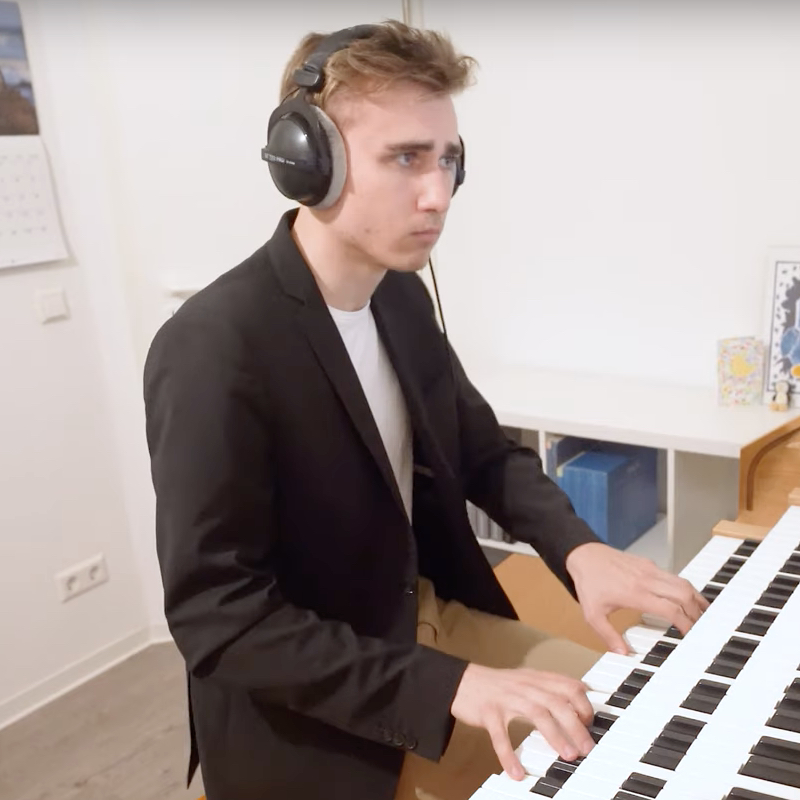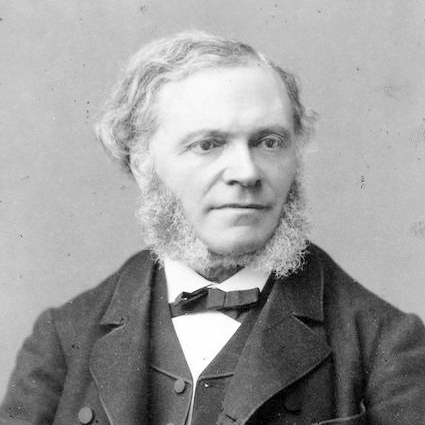Madison Symphony Orchestra Program Notes
Overture Concert Organ Series No. 1
September 27, 2022
J. Michael Allsen
This
opening program of
the 2022-23 Overture Concert Organ Series features the
Madison Symphony
Orchestra’s principal organist, Greg Zelek, and begins with
the premiere of a
work dedicated to him, the brilliant Toccata
by Paul Fey. The next work is Zelek’s own adaptation of the
impressionistic Clair
de lune by Claude Debussy. After a
pair of masterful fugues written by a very young J.S. Bach,
Zelek presents two
American works: John Weaver’s virtuosic Fantasia,
and the lush, romantic Adoration by
Florence Price. The
closer is César
Franck’s
Grande Pièce Symphonique, a landmark work from
19th-century France.
 Paul
Fey (b. 1998)
Paul
Fey (b. 1998)
Toccata
(premiere
performance)
The
young German composer
and organist Paul Fey was born in a small town near Leipzig.
After initially
studying classical guitar and piano, he discovered the pipe
organ at his local
church when he was a teenager. Fey notes that “I went on to
practice and
experiment on this instrument for several hours at a time,
never once getting
tired of all of the possible combinations of the different
timbres. The pipe
organ increasingly gripped my full attention, so I put the
guitar lessons ‘on
hold’ in order to get my first organ lessons from A.F.
Kipping, as well as
studying with Stefan Kießling (the former assistant organist
at the St. Thomas
Church in Leipzig).” He
later studied
organ and sacred music at the University of Halle. Today, in
addition to
working as an organist, Fey produces an extensive YouTube
channel featuring
performances of both his own music and the music of other
organ composers. The
Toccata
premiered here was commissioned by William Steffenhagen, a
longtime member of
the Friends of the Overture Concert Organ. The work is
dedicated to Greg Zelek.
According to Fey, Mr. Zelek requested something “shiny and
exciting”—and the Toccata
is certainly successful on both
counts! It opens with a fiery set of figures on the manuals,
and then the
pedals provide a melody to go with this accompaniment. After
a brief
contrasting section, Fey provides a short pedal cadenza,
which he says “should
be pretty interesting for the audience to watch.” The Toccata closes with a brief reprise of the
opening music and a powerful
ending.
 Claude Debussy (1862-1918)
Claude Debussy (1862-1918)
Clair de lune (arr. Greg Zelek)
As a young man, Claude
Debussy earned a reputation, in
Paris at least, as
one of the late 19th century’s great pianists: not in
the large-scale flashy
public concerts typical of virtuoso performers but as a
young “bohemian” in the
cool, intellectual atmosphere of Paris’s cafés and
artistic salons. His Clair de lune (Moonlight) is the third movement of the Suite Bergamasque for solo piano. It was
written in about 1890 and
revised prior to its publication in 1905. Inspired by a
Symbolist poem by his
friend Paul Verlaine,
Clair de lune
is quite possibly Debussy’s best-known work. It has been
adapted for innumerable
instruments and ensembles. In Greg Zelek’s sensitive
adaptation for solo organ,
its lush and sensuous melodic line is played above a
shimmering and static
harmonic background.
 Johann
Sebastian Bach
(1685-1750)
Johann
Sebastian Bach
(1685-1750)
“Little” Fugue in G minor, BWV 578
“Gigue” Fugue in G Major, BWV 577
J.S. Bach was of course the grandmaster
of the Baroque
fugue, and this program features two examples of the form,
both composed when
he was a young man. Bach’s “Little” Fugue
in G minor (so-named to distinguish it from the
slightly longer “Great”
Fantasia and Fugue in G minor, BWV 542) was
composed sometime
before 1707, when Bach was in Arnstadt, serving as organist
in in the Neukirche
(“new church”) there. Bach at age 18 had taken a position as
musician at the
court of Weimar, but he quickly found a better post at
Arnstadt. A small city
in central Germany, about 40 miles from Bach’s hometown of
Eisenach, Arnstadt
was a fairly provincial and rather dull place at the time,
but it proved to be
a good initial position. Bach had a particularly fine new
organ to work with,
and set about composing an impressive set of works for the
instrument,
including this famous fugue.
The “Gigue” Fugue in G
Major was often regarded as spurious—as a work
misattributed to Bach—but
recent writers tend to support his authorship. It also seems
to have been a
relatively early work, perhaps as early as his first
professional organ jobs in
Arnstadt (1703-07) or Mühlhausen (1707-08). The “Gigue” Fugue, named for its lively subject in
gigue (or jig) rhythm, is remarkably similar
to a couple of works
by the composer Dieterich Buxtehude, particularly his “Gigue” Fugue in C Major. This musical
connection makes perfect
sense in a work by the young Bach, who admired Buxtehude
above all other
composers. While was working in Arnstadt, Bach famously took
a four-month leave
to walk the 280 miles to the northern port city of Lübeck in
order to study
with Buxtehude. Bach’s “Gigue” Fugue
is a bravura piece with particularly impressive pedal lines.
Its dancelike
texture builds up a tremendous rhythmic tension that only
resolved in the final
measures.
 John Weaver (1937-2021)
John Weaver (1937-2021)
Fantasia
Born in Pennsylvania, organist and
composer John Weaver
taught organ at the Curtis Institute in Philadelphia and
also served as head of
the organ department at New York’s Juilliard School. In
1970, he was appointed
organist at the Madison Avenue Presbyterian Church in New
York City, a position
he held until his retirement in 2005. His 1977 Fantasia is a
brilliant
showpiece for both the organist and the organ.
It is in four connected sections, with the opening Allegro based upon a restless,
forcefully-accented theme. The
Scherzo
playfully explores the idea
above long-held pedals, before moving into a more
mysterious and modal Adagio. The Finale presents a brilliant, contrapuntal
version of the opening
idea.
 Florence
Price
(1887-1953)
Florence
Price
(1887-1953)
Adoration
The music of Florence
Price has
attracted tremendous
interest in recent years—and justifiably so: here is an
20th-century American
composer of the first rank, whose works have largely been
rediscovered only in
the last dozen years. Greg Zelek has already taken part in
this “Price
Renaissance,” performing her Suite No. 1
here last season, and recently making one of the first
recordings of the piece.
At this program, he performs her Adoration. Born in Little
Rock, Arkansas, into a
well-respected family—her father was the only Black dentist
in this strictly
segregated city—Price studied at the New England
Conservatory of Music. She
then taught music for several years in Atlanta and Little
Rock, but following a
lynching in Little Rock in 1927, her family resettled in
Chicago, where she
would spend the rest of her life. It was in Chicago that
Price finally began to
have success as a composer, culminating in 1933, when her Symphony No.1 was performed by the Chicago
Symphony Orchestra—the
first work by an African-American woman to be played by a
major orchestra.
Though her music was performed and championed by star
performers like Marian
Anderson, she struggled to make ends meet throughout her
life. Price studied
organ at the New England Conservatory, and played frequently
in Boston as an
organ accompanist and soloist. After graduation, she briefly
worked as a church
organist at the Unitarian Church in Nantick, Massachusetts,
but it is unclear
whether or not she ever had a regular church position after
this. However,
after moving to Chicago, Price studied at the American
Conservatory of Music’s
newly-established School of Theatre Organ, and worked
frequently as a theatre
organist for the next few years. She was also part of the
Chicago Club of Women
Organists, and she frequently performed at the club’s
concerts, often
presenting her own music. Unlike the great majority of
Price’s organ works, Adoration
was actually published during
her lifetime, appearing in print in 1951. The style of this
brief work is
thoroughly romantic, with the opening section setting a
lovely, lyrical tune.
After a short transition there is a contrasting episode: an
equally lyrical
melody with a chromatic accompaniment.
The piece ends with a return of the opening music and
a hushed
ending.
 César Franck (1822-1890)
César Franck (1822-1890)
Grande Pièce Symphonique, Op. 17
The Belgian-born organist and composer
César Franck cast
a long shadow over the organ
music of 19th-century France. He began studies at the Paris
Conservatory as a
teenager, but never completed his studies there. He
eventually returned to
Paris in 1845, securing a series of increasingly prestigious
organ jobs that
culminated in his appointment as organist at the church of
Sainte-Clothilde in
1858. In 1872, Franck acquired the most influential organ
position in France:
he became organ professor at the Paris Conservatory,
remaining there until his
death in 1890. Franck gathered a large and devoted group of
students that
included Louis Vierne, Vincent D’Indy, and Ernest Chausson.
Like many of his organ works, the Grande Pièce Symphonique, completed in 1862,
was designed for the
new style of large organ pioneered by the French builder
Aristide
Cavaillé-Coll. This work was one of several Franck composed
shortly after
Sainte-Clothilde installed a new Cavaillé-Coll instrument in
1859. It is also
an experiment in applying symphonic form to a work for solo
organ: it is set in
three large movements, and in true symphonic form, Franck
develops a few main
themes across all movements. The opening Andante
serioso is an introduction, based upon a wandering
line and a gentle
syncopated idea. After a climactic conclusion, this leads
into the main body of
the movement (Allegro
non troppo e
maestoso), set in sonata form. There are two main
ideas: a forceful main
theme, and a gentler chorale-style second theme. In the
brief development
section, Franck refers to the syncopated idea from the
introduction, before the
pedals begin a quiet recapitulation of the main themes. The
theme from the
introduction makes a hushed appearance in the final
measures. The slow movement
(Andante) develops
a lyrical, richly
chromatic idea heard at the beginning. There is an abrupt
change in character
and tempo (Allegro)—essentially
the
“scherzo” of symphonic form. This restless minor-key episode
eventually closes
with a short fanfare before returning to the Andante theme to close the movement. The
closing movement (Allegro
non troppo e maestoso) begins
with a review of themes from the previous two movements,
linked by statements
of the first movement’s Allegro theme
in the pedals. An exalted version of this Allegro
theme then emerges as the main idea of this movement. After
an extended fugue
on this theme, Franck ends his Grande
Pièce with
a suitably grand coda.
________
program
notes ©2022 by J.
Michael Allsen